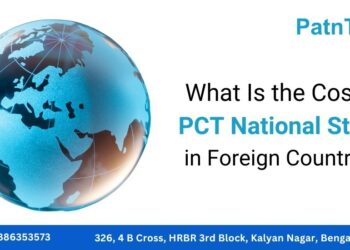Trademark Renewal
- January 4, 2021
- Posted by: Patntech
- Categories: Blog, Trademark

Trademark Renewal Process in India
Trademark is the name or representative logo of a company or products/services offered by the company. Sometimes, name of the company itself creates a goodwill in the minds of customers and people in general. People recognise the company and its products/services all over with the same mark that represents them. The brand name under which the goods and services are served become their asset. It is important for the companies to protect the name of the company or product from being copied by others. Trademark offers the company or trademark owner a right to prevent a third party from misusing or taking undue advantage of the registered trademark.
In India, the trademark protection is sought by registering the marks with the Office of the Controller General of Patents, Designs & Trademarks. Once registered, the trademark registration is valid for 10 years from the date of application. The trademark can be renewed every ten years to continue enjoying the right offered to the trademark owner perpetually. Failure to renew allows third parties to misuse or misappropriate the trademark. Therefore, it is important to renew the registration to keep the trademark protected forever.
Trademark Renewal Procedure:
The Registrar of trademark will send a notification (Form RG-3) prior to the expiry informing the registered proprietor with regard to the renewal. The registered proprietor can file an application for renewal of trademark anytime in Form TM-R within one (1) year prior to the expiry of the trademark registration.
If the registered proprietor fails to renew before the expiry of the trademark registration, then the registered proprietor can file a renewal request within six (6) months after the expiry of the registration. Here, the registered proprietor has to pay late or surcharge fee in addition to the renewal fee.
If the registered proprietor for reasons unforeseen or by negligence is unable to renew the trademark even during the extended period of 6 months, then the registered proprietor can apply for restoration of trademark under section 25 (4) of the Trademark Act, 1999. The application for restoration has to be filed within one (1) year from the date of expiration of the trademark. In other words, the application for restoration can be filed after six months and within twelve months of the expiry of the registered mark in Form TM-R with the restoration fees as per class in addition to the required renewal fee.
The documents required for trademark renewal procedure includes a copy of the Registration certificate and power of attorney. The current fee structure for renewing trademark registration under various circumstances is given below. The fee structure given below may change from time to time as per the notification issued by the Trademark Registry.
Application for Cost for Physical filing Cost for E-filing Renewal of Trademark ₹10,000 ₹9,000 Renewal with Surcharge ₹5,000 + the renewal fees ₹4,500 + the renewal fees Renewal with Surcharge/Restoration ₹10,000 + the renewal fees ₹9,000 + the renewal fees
The trademark registrar reviews the application for trademark renewal or restoration and either accepts or rejects the application. The trademark registrar accepts the application for trademark renewal within the same year or the next year on the condition that:
- There has been no bona fide trade use of the trade mark which had been removed during two years immediately preceding its removal;
- No confusion has raised from the use of the trade mark which is applied for registration by reason of any previous use of trade mark which has been used.
After the Registrar’s acceptance of the renewal or restoration, the Registrar will issue a certificate of renewal of trademark to the registered proprietor confirming his continued ownership. The renewal or restoration will be advertised in the Trademark Journal which will extend the trademark protection for following period of ten years.
Author: Sneha V K
AIPPI World Congress, Yokohama, Japan
We are pleased to share that PatnTech’s Managing Partner, Mr. Chandrasekhar Raju, attended the AIPPI World Congress held in Yokohama, Japan, from September 13–16, 2025.
October 1, 2025
What Is the Cost of PCT National Stage in Foreign Countries?
The Patent Cooperation Treaty (PCT) simplifies patent protection for companies and inventors worldwide
August 6, 2025
The Importance of US Design Patents for Innovators: Insights from PatnTech
In today’s competitive marketplace, innovation drives success, and protecting those innovations is crucial.
July 21, 2025
How to Apply for a US Design Patent: Your Step-by-Step Guide
A US design patent protects the unique ornamental design of an article of manufacture. It helps businesses and inventors safeguard their innovative creations.
July 10, 2025
Trademark Renewal Process in India
Trademark is the name or representative logo of a company or products/services offered by the company. Sometimes, name of the company itself creates a goodwill in the minds of customers and people in general. People recognise the company and its products/services all over with the same mark that represents them. The brand name under which the goods and services are served become their asset. It is important for the companies to protect the name of the company or product from being copied by others. Trademark offers the company or trademark owner a right to prevent a third party from misusing or taking undue advantage of the registered trademark.
In India, the trademark protection is sought by registering the marks with the Office of the Controller General of Patents, Designs & Trademarks. Once registered, the trademark registration is valid for 10 years from the date of application. The trademark can be renewed every ten years to continue enjoying the right offered to the trademark owner perpetually. Failure to renew allows third parties to misuse or misappropriate the trademark. Therefore, it is important to renew the registration to keep the trademark protected forever.
Trademark Renewal Procedure:
The Registrar of trademark will send a notification (Form RG-3) prior to the expiry informing the registered proprietor with regard to the renewal. The registered proprietor can file an application for renewal of trademark anytime in Form TM-R within one (1) year prior to the expiry of the trademark registration.
If the registered proprietor fails to renew before the expiry of the trademark registration, then the registered proprietor can file a renewal request within six (6) months after the expiry of the registration. Here, the registered proprietor has to pay late or surcharge fee in addition to the renewal fee.
If the registered proprietor for reasons unforeseen or by negligence is unable to renew the trademark even during the extended period of 6 months, then the registered proprietor can apply for restoration of trademark under section 25 (4) of the Trademark Act, 1999. The application for restoration has to be filed within one (1) year from the date of expiration of the trademark. In other words, the application for restoration can be filed after six months and within twelve months of the expiry of the registered mark in Form TM-R with the restoration fees as per class in addition to the required renewal fee.
The documents required for trademark renewal procedure includes a copy of the Registration certificate and power of attorney. The current fee structure for renewing trademark registration under various circumstances is given below. The fee structure given below may change from time to time as per the notification issued by the Trademark Registry.
| Application for | Cost for Physical filing | Cost for E-filing |
| Renewal of Trademark | ₹10,000 | ₹9,000 |
| Renewal with Surcharge | ₹5,000 + the renewal fees | ₹4,500 + the renewal fees |
| Renewal with Surcharge/Restoration | ₹10,000 + the renewal fees | ₹9,000 + the renewal fees |
The trademark registrar reviews the application for trademark renewal or restoration and either accepts or rejects the application. The trademark registrar accepts the application for trademark renewal within the same year or the next year on the condition that:
- There has been no bona fide trade use of the trade mark which had been removed during two years immediately preceding its removal;
- No confusion has raised from the use of the trade mark which is applied for registration by reason of any previous use of trade mark which has been used.
After the Registrar’s acceptance of the renewal or restoration, the Registrar will issue a certificate of renewal of trademark to the registered proprietor confirming his continued ownership. The renewal or restoration will be advertised in the Trademark Journal which will extend the trademark protection for following period of ten years.
Author: Sneha V K
AIPPI World Congress, Yokohama, Japan
We are pleased to share that PatnTech’s Managing Partner, Mr. Chandrasekhar Raju, attended the AIPPI World Congress held in Yokohama, Japan, from September 13–16, 2025.
October 1, 2025What Is the Cost of PCT National Stage in Foreign Countries?
The Patent Cooperation Treaty (PCT) simplifies patent protection for companies and inventors worldwide
August 6, 2025The Importance of US Design Patents for Innovators: Insights from PatnTech
In today’s competitive marketplace, innovation drives success, and protecting those innovations is crucial.
July 21, 2025How to Apply for a US Design Patent: Your Step-by-Step Guide
A US design patent protects the unique ornamental design of an article of manufacture. It helps businesses and inventors safeguard their innovative creations.
July 10, 2025




